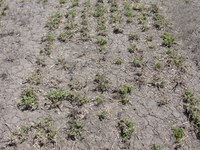Producers May Be Dealing With Winter-killed Alfalfa
(Click the image below to view a high-resolution image that can be downloaded)
Winter-killed alfalfa may be a widespread problem this year in North Dakota and northern Minnesota because of drought conditions.
The northern Plains has been experiencing severe drought since 2020, with alfalfa plants stressed due to a shortage of water. The lack of snow cover and almost two weeks with temperatures below 0 F in February likely has caused alfalfa winter-kill.
“Alfalfa crowns tolerate temperatures down to 5 F, but without snow cover to insulate alfalfa plants and temperatures dropping below 0 F for at least 10 days in a row in February, alfalfa plants were damaged or winter-killed,” says Marisol Berti, North Dakota State University forages and biomass crops specialist.
“Before deciding what the best options are to have enough forage this season, farmers and ranchers must assess the alfalfa plant stands,” says Kevin Sedivec, NDSU Extension rangeland management specialist.
Berti recommends walking the entire field to look for healthy, injured and dead plants. Some areas might have more winter-kill than others. Low areas of the field are more prone to winter-kill and injury.
First, look at the top of the plant, assessing the number of shoots greening up and the symmetry or distribution of them in the crown. A healthy plant will have many shoots coming from all sides of the crown.
A plant with asymmetrical distribution of shoots, meaning shoots growing on only one side of the crown, has winter-injury. This plant will be lower yielding due to fewer shoots, but also some shoots will be developed later and be behind in growth.
In newly seeded alfalfa, look for crowns that have been pushed out from the ground 1 inch or more. This is called heaving. Heaved plants will die eventually.
Second, dig up a few plants and look at the health of the crown and root. Split the root. A healthy root is turgid and firm, and has an off-white color and little or no crown rot symptoms. If the root looks dehydrated or stringy, it might not be dead but it is injured and likely will die.
A less healthy plant will have signs of rot in the crown but also inside the root. A winter-killed plant will have no top growth, and the crown and root will be soft and can be pulled out of the ground easily.
Count the stems of healthy plants or slightly injured plants. Use a 2-foot square frame and divide the number of healthy plants by two. Sample several areas of the field that represent the whole field.
Before deciding to keep or replace the stand, consider the stand age. For example, less than seven plants per square foot is considered poor in a 1-year-old stand, while less than four plants per square foot is classified as poor in a 4-year-old stand.
Also, research has shown that counting stems (shoots) instead of plants better predicts the yield of the stand, especially in older stands. Stem counts of greater than 50 stems per square foot are considered adequate for 1-year-old stand and greater than 30 stems per square foot are adequate for a 4-year-old stand.
“Forage options for winter-killed alfalfa vary depending on the calendar date, timing, urgency for feed, economics and forage yield,” Berti says. “Early identification of the problem will provide sufficient time for the grower to establish a new perennial forage pasture or an annual cool-season forage.”
Alfalfa cannot be seeded into alfalfa. Newly seeded alfalfa will die from autotoxins released to the soil by the alfalfa crown and roots.
Annual cool-season grasses such as oats or forage barley (awnless) can be interseeded in the alfalfa field and harvested for hay. Barley will do better in droughty conditions than oats. Oats and barley do not grow well once the weather gets hot.
Forage options for late summer or early fall harvest include warm-season forages such as sorghum x sudangrass, sudangrass, foxtail millet and pearl millet. Warm-season forages will provide a good alternative to seed after harvesting a cool-season forage grass.
“For severe winter-killed alfalfa, establishing perennial grasses is the best option if the field will remain as hay ground,” Sedivec says. “However, perennial grasses will not produce much forage in the establishment year. Meadow brome or intermediate wheatgrass are also more tolerant to drought than annual grasses.”
NDSU Agriculture Communication - May 10, 2021
Source: Kevin Sedivec, 701-424-3606, kevin.sedivec@ndsu.edu
Source: Marisol Berti, 701- 231-6110, marisol.berti@ndsu.edu
Editor: Ellen Crawford, 701-231-5391, ellen.crawford@ndsu.edu


